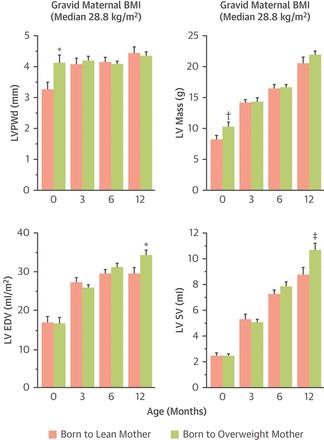JACC: Cardiovascular Imaging ( IF 12.8 ) Pub Date : 2018-12-01 , DOI: 10.1016/j.jcmg.2017.08.024 Maria Angela Guzzardi , Tiziana Liistro , Luna Gargani , Lamia Ait Ali , Gennaro D’Angelo , Silvia Rocchiccioli , Federica La Rosa , Alessandra Kemeny , Elena Sanguinetti , Nadia Ucciferri , Mariarosaria De Simone , Antonietta Bartoli , Pierluigi Festa , Piero A. Salvadori , Silvia Burchielli , Rosa Sicari , Patricia Iozzo

|
Objectives The aim of this study was to investigate the consequences of maternal overweight on cardiac development in offspring in infants (short term) and minipigs (short and longer term).
Background The epidemic of overweight involves pregnant women. The uterine environment affects organ development, modulating disease susceptibility. Offspring of obese mothers have higher rates of cardiovascular events and mortality.
Methods Echocardiography was performed in infants born to lean and overweight mothers at birth and at 3, 6, and 12 months of age. In minipigs born to mothers fed a high-fat diet or a normal diet, cardiac development (echocardiography, histology), glucose metabolism and perfusion (positron emission tomography), triglyceride and glycogen content, and myocardial enzymes regulating metabolism (mass spectrometry) were determined from birth to adulthood.
Results In neonates, maternal overweight, especially in the last trimester, predicted a thicker left ventricular posterior wall at birth (4.1 ± 0.3 vs. 3.3 ± 0.2 mm; p < 0.05) and larger end-diastolic and stroke volumes at 1 year. Minipigs born to mothers fed a high-fat diet showed greater left ventricular mass (p = 0.0001), chambers (+100%; p < 0.001), stroke volume (+75%; p = 0.001), cardiomyocyte nuclei (+28%; p = 0.02), glucose uptake, and glycogen accumulation at birth (+100%; p < 0.005), with lower levels of oxidative enzymes, compared with those born to mothers fed a normal diet. Subsequently, they developed myocardial insulin resistance and glycogen depletion. Late adulthood showed elevated heart rate (111 ± 5 vs. 84 ± 8 beats/min; p < 0.05) and ejection fraction and deficient fatty acid oxidative enzymes.
Conclusions Neonatal changes in cardiac morphology were explained by late-trimester maternal body mass index; myocardial glucose overexposure seen in minipigs can justify early human findings. Longer term effects in minipigs consisted of myocardial insulin resistance, enzymatic alterations, and hyperdynamic systolic function.
中文翻译:

目的这项研究的目的是调查母体超重对婴儿(短期)和小型猪(短期和长期)后代心脏发育的影响。
背景超重的流行病涉及孕妇。子宫环境影响器官发育,调节疾病易感性。肥胖母亲的后代有较高的心血管事件发生率和死亡率。
方法对出生于体重分别为3、6和12个月的瘦身和超重母亲所生的婴儿进行超声心动图检查。在高脂饮食或正常饮食的母亲所生的小型猪中,确定了心脏发育(超声心动图,组织学),葡萄糖代谢和灌注(正电子发射断层扫描),甘油三酸酯和糖原含量以及调节代谢的心肌酶(质谱)。从出生到成年
结果在新生儿中,孕妇超重,尤其是在最后三个月,预示着出生时左心室后壁较厚(4.1±0.3 vs. 3.3±0.2 mm; p <0.05),并且在1年时舒张末期和中风量更大。高脂饮食的母亲所生的小型猪表现出更大的左心室质量(p = 0.0001),室(+ 100%; p <0.001),中风量(+ 75%; p = 0.001),心肌细胞核(+ 28% ; p = 0.02),出生时的葡萄糖摄取和糖原蓄积(+ 100%; p <0.005),与正常饮食的母亲相比,具有较低的氧化酶水平。随后,他们发展了心肌胰岛素抵抗和糖原耗竭。成年后期显示出较高的心率(111±5 vs. 84±8次/分钟; p <0.05),射血分数和脂肪酸氧化酶不足。
结论孕晚期孕妇体重指数可以解释新生儿心脏形态的变化。小型猪中出现的心肌葡萄糖过度暴露可以证明人类早期发现的合理性。小型猪的长期影响包括心肌胰岛素抵抗,酶促改变和收缩期功能亢进。











































 京公网安备 11010802027423号
京公网安备 11010802027423号